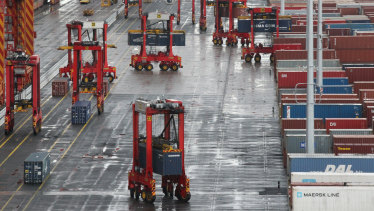Jobs Australia chief operating officer Nicole Steers said trying to properly prepare the unemployed in a world where many lower-skilled jobs were disappearing would put pressure on training providers and the federal government.
“This is going to be an issue for the federal government as it tries to get people into work but don’t have the skills being demanded,” she said.
“It’s going to have to develop more programs for skill development.”
Ms Steers said the increasing use of automatic checkouts in supermarkets was an example of the problem facing lower-skilled workers and those looking to get into the jobs market.
Employment in the supermarket and grocery sector grew by more than 26,000 in the five years to the middle of last year, partly on the back of an expansion in the number of stores to deal with Australia’s growing population.
But most chains have signalled greater use of automatic checkouts, in part due to growing consumer demand for the service.
Ms Steers said there was nothing wrong with companies adapting new technology.
But there would be issues as that technology came to replace workers.
“Greater automation, and it makes perfect sense for the companies to go down this path, it’s going to have a much larger impact on those people,” she said.
“In some of these places there have been people with disabilities for some time. They are going to need more support.”
It’s not just those in the workforce facing issues.
New reseach compiled by the OECD, based on questions to teenagers across more than 50 nations, found that around 35 per cent of the jobs cited by Australian high school students as their prospective career were at risk of automation.

An automated terminal at Port Botany, where machines load vast volumes of goods onto ships without touching human hands. A recent OECD survey shows more than a third of Australian teenagers want to work in areas at risk of being replaced by machines.Credit:Peter Rae
In some countries such as Germany and Japan, more than 45 per cent of jobs picked by teenagers as possible careers are at risk of being replaced by a machine.
Disadvantaged children were more likely to identify a future occupation that may disappear than those from higher socio-economic backgrounds. Boys were at greater risk of planning for an at-risk career than girls.
The same research also shows a narrow focus for most teenagers on their working years.
Loading
Fifty-two percent of Australian girls and 42 per cent of boys believe they will be employed in one of 10 jobs, including being a doctor, a motor mechanic, a nurse or a sportsperson.
Shane is a senior economics correspondent for The Age and The Sydney Morning Herald.
Most Viewed in Politics
Loading